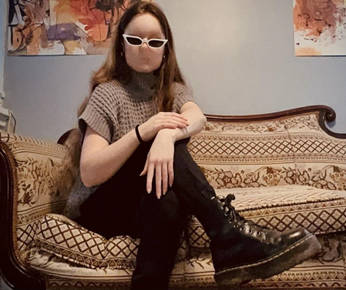Anabel Rattray
Artwork images from Weatherspoon Art Museum database; self-portraits courtesy of author
Fashion exists at the crossroads of art and life. The self-expression inherent to making art becomes even more potent, obvious, and chic through fashion. Think of almost everyone you have met: your friends, family, classmates. Then think of the clothes they wear. Are they similar to yours? Are they different? You can picture each person’s fashion as distinctly theirs. Someone’s look is often the first thing we notice; thus, fashion is one of the most essential expressions of identity.
I challenged myself to recreate five paintings from the Weatherspoon Art Gallery through my clothing, attempting to capture their color palettes and their impression on me. I wanted to become the artwork. Below are the results of my efforts, along with information on the paintings and my chosen outfits from the week, which capture the idea of fashion as a medium for inward and outward artistic exploration.
Note: I blurred my face for anonymity and artistic purposes.
Monday

Kiyoshi Saito, “Black and Grey Cat.”

I paired black jogger pants with a gray formless sweater. White cat-eye glasses with gold accented jewelry mimicked the woodblock print’s white and yellow tones. Saito was a Japanese artist born in Fukushima Prefecture, Japan, who studied drawing and painting before becoming a printmaker. Saito’s print “Steady Gaze” won a major prize in 1951, which marked the rise in popularity and perception of the print medium in Japan. Saito’s most lasting legacies are his “bold blocks of color, refined designs, and rich texture,” which I tried to replicate in my multi-textural outfit combination.
Tuesday

John Sonsini, “David.”

I became a study of Sonsini’s oil painting with this outfit. Red and brown were prominent in my closet, so I easily found clothing similar to the subject’s. My half bun suggested the sideways baseball hat. I utilized soft fabrics to mimic Sonsini’s soft, evocative brushstrokes, and I framed the picture against the blue-tinted wall to achieve a similar ambiance.
Wednesday

Jimmy Ernst, “Dark Red Mountain.”

My velvet cardigan evoked the striations of Ernst’s mountain, and I braided my hair to match. This painting reflects Ernst’s exploration of Abstract Expressionism after his foundation in Surrealism (famous surreal artist Max Ersnt was his father). By the time of this painting, he had become a member of The Irascibles. This art movement protested the Metropolitan Museum of Art’s resistance to abstract art in juried exhibitions. The landscape also demonstrates the linear precision of his earlier abstract style. My post and the silver necklace were also supposed to suggest the piece’s angular aspects.
Thursday



A plaid skirt, green sweater, and red scarf imitated the artwork’s figures. I added saddle shoes to reference the painting’s title and the figures’ dual-toned footwear. The sheer white jacket draped on my shoulders was my version of the horse on my back. Cutler’s artwork often portrays women doing difficult tasks and standing in compromising positions. It demonstrates how historical sources like folk traditions still resonate with women’s identities. I wanted to represent the importance of textiles in Cutler’s work by incorporating as many textural components as possible without compromising the ensemble’s integrity.
Friday

Diane Arbus, “Man and a Boy on a Bench in Central Park, NYC.”

The last day of outfits, and probably my favorite, involved me trying more masculine-presenting fashions. Though the picture is black and white, I chose a pink and red ladybug scarf to echo the foliage behind the pair. Its chiffon texture also stood in for the boy’s presence. Arbus was an American photographer who liked to photograph transgender people, those deemed mentally ill, and people she encountered on the New York City streets. I used a stylized pose to reflect the man’s refinement and elegance.
Friday ended my week of exploration along the boundary of art and fashion. As many artists attempted to portray identity through their work, I spent the week considering what my clothing suggested about my identity. I wondered what I was wearing and who I was that day. If art is the exploration of the human condition, perhaps fashion is the exploration of the humans wrapped up in that condition.

